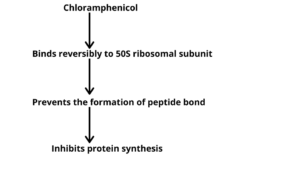Introduction of chloramphenicol
Chloramphenicol is a broad-spectrum antibiotic but its use is limited to only a few conditions because of its dangerous side effect that is bone marrow suppression.
The chloramphenicol is isolated from soil-dwelling Gram-positive bacterium Streptomyces venezuelae.
Mechanism of action of chloramphenicol
The chloramphenicol is a bacteriostatic agent, but in high concentration, it can be bactericidal effects. The drug binds reversibly to the 50S ribosomal subunit that leads to prevents the formation of a peptide bond.
And ultimately inhibits protein synthesis and also inhibits mitochondrial protein synthesis in mammalian cells by acting on 70S ribosomes.

Pharmacokinetics
In the oral route, it is rapidly absorbed from the gut. It was also available for parenteral and topical administration. Bitter taste; to improve the taste.
It is widely distributed to all tissues including CSF and the brain. It crosses the placental barrier and is secreted in milk.
The drug is metabolized in the liver by glucuronide conjugation and the metabolite is excreted mainly in the urine.
Adverse effects of chloramphenicol
The various side effects are present in the drugs but some common side effects are seen below;
- Hypersensitivity reactions: skin rashes, drug fever, and angioedema
- Bone marrow suppression
- It is due to dose-dependent reversible suppression of bone marrow, which manifests as anemia, leukopenia, and thrombocytopenia.
- It also due to idiosyncratic condition non-dose-related irreversible aplastic anemia, which is often fatal.
- Gastrointestinal effects: nausea, vomiting, and diarrhea
- Gray baby syndrome
- It is most commonly seen in neonates, especially premature babies, due to reduced degradation and detoxification of the drug in the liver because of the deficiency of glucuronyl transferase enzyme.
- The symptoms are nausea, vomiting, abdominal distension, refusal to shock, diarrhea, cyanosis, irritability, and circulatory collapse. The skin appears pale grey in color so named Gray baby syndrome.
Therapeutic uses
- Typhoid fever ( First choice of drug)
- Bacterial meningitis
- Anaerobic infections (B. fragilis)
- Rickettsial infections (Most commonly used to treat rickettsial infections in children and pregnant women).
- Eye and ear infections
- Brucellosis (It is only used when tetracyclines are contraindicated).
[embeddoc url=”https://notesmed.com/wp-content/uploads/2021/05/Chloramphenicol.pdf” download=”all” cache=”off” text=”Complete notes- Download”]





